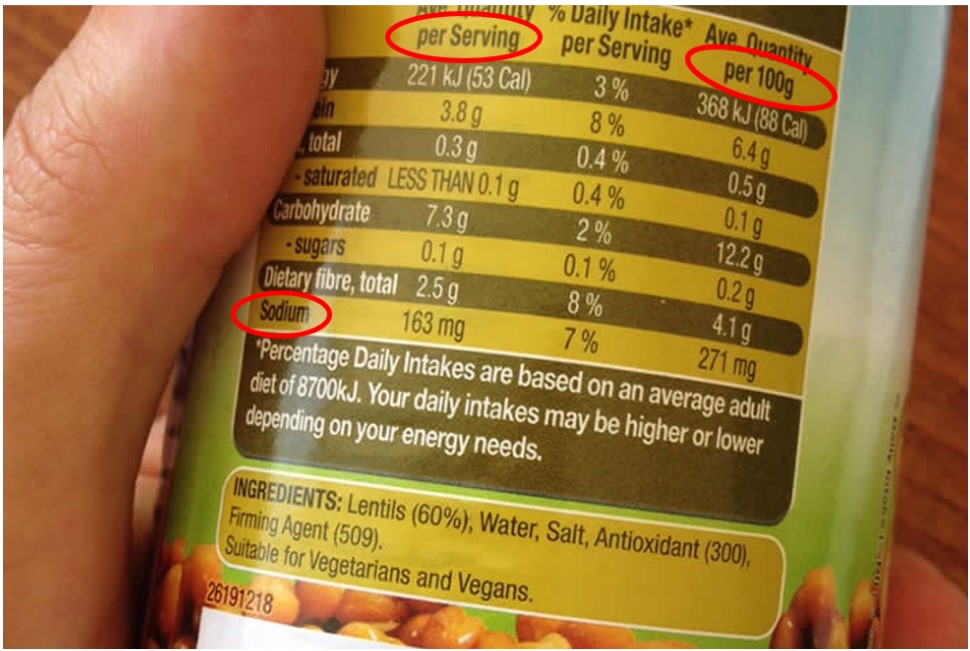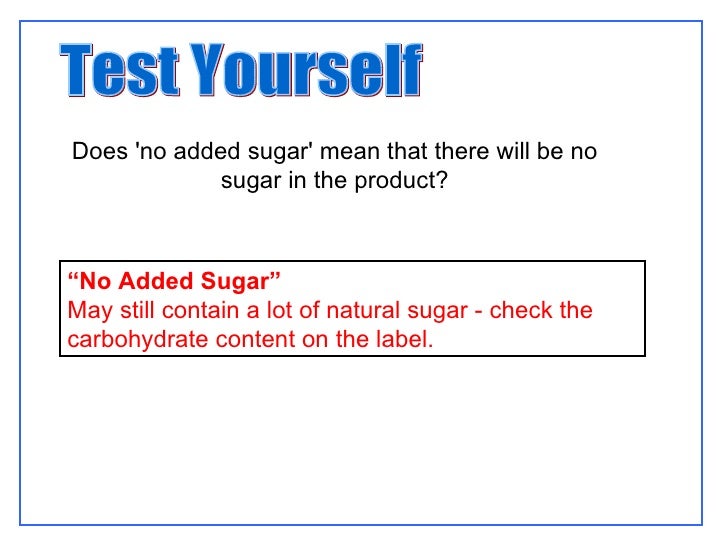40 how to read food labels for sugar content
How To Read Food and Beverage Labels | National Institute on Aging Be on the lookout for terms that indicate added sugar, such as brown sugar, corn sweetener, corn syrup, dextrose, fructose, and high-fructose corn syrup. Artificial sweeteners such as sucralose, saccharin, aspartame, and acesulfame should also be consumed in moderation. Understanding food labels - Diabetes UK Check the ingredients list - if syrup, invert syrup, cane sugar, molasses or anything ending in 'ose' is within the first three ingredients, this suggests the food contains more added sugar. Choose an alternative if possible, or be mindful of the portion you eat. Check the fibre content on the back of pack label.
How to read food labels: MedlinePlus Medical Encyclopedia Always check the serving size first. All the information on the label is based on the serving size. Many packages contain more than 1 serving. For example, the serving size for spaghetti is most often 2 ounces (56 grams) uncooked, or 1 cup (0.24 liters) cooked. If you eat 2 cups (0.48 liters) at a meal, you are eating 2 servings.

How to read food labels for sugar content
How to Read Food Labels and Understand Sugar Content - yum. Gluten Free The NIP on a label shows the amount of certain nutrients found in a stated amount of the product. These nutrients include energy, protein, fat (total and saturated), carbohydrate (total and sugars) and sodium. There may be further categories and/or subset of these categories, for example, 'sugars' is a subset of 'carbohydrates'. How to Read Food Labels Without Being Tricked - Healthline This label usually means that the fat has been reduced at the cost of adding more sugar. Be very careful and read the ingredients list. Low-carb. Recently, low-carb diets have been linked to... Food Labels | CDC Check the Serving size first. All the numbers on this label are for a 2/3-cup serving. This package has 8 servings. If you eat the whole thing, you are eating 8 times the amount of calories, carbs, fat, etc., shown on the label. Total Carbohydrate shows you types of carbs in the food, including sugar and fiber.
How to read food labels for sugar content. Added Sugars on the New Nutrition Facts Label | FDA Single-Ingredient Sugars and Syrups Sample Label Let the Nutrition Facts Label Be Your Guide The new Nutrition Facts label can help you compare and choose foods that are lower in added sugars.... How to read labels for added sugar - That Sugar Movement One: Look for foods under 5g total sugar/100g In Australia, the Nutrition Information Panel (NIP) on the back of food and drink packaging lists total sugars content. It does not separate intrinsic sugars from added sugars. Yet, it is the added sugars - not those that are intrinsic or naturally-occurring in whole foods - that we are concerned with. This Is How to Read a Nutrition Facts Label on the Keto Diet That's not a 33% fat, 33% carb, 33% protein ratio. It's actually 52% fat, 24% carb, 24% protein. This may sound a little confusing, but as long as you limit carbs (the most important part) and aim for healthy fats and protein to make up a majority of your daily macronutrient intake, your results should be excellent. Learning To Read Labels - Diabetes Education Online On a nutrition food label, subtract the fiber from the total carbohydrate amount. When you read food labels, the grams of sugar are already included in the total carbohydrate amount, so you do not need to count this sugar amount separately. The grams of sugar listed include both natural sugars, from fruit or milk, and added sugars.
Sugars on food labels - Sugar Nutrition Resource Centre The Food Standards Code specifies the rules around sugars in the ingredients list as follows -. (a) The name 'sugar' may be used to describe: white sugar; or white refined sugar; or caster sugar or castor sugar; or loaf sugar or cube sugar; or icing sugar; or coffee sugar; or coffee crystals; or raw sugar. (b) The name 'sugars' must not ... How to Understand and Use the Nutrition Facts Label | FDA manufacturers are encouraged, but not required, to use the "†" symbol immediately following the added sugars percent daily value on single-ingredient sugars, which would lead to a footnote... How To Easily Read The Sugar Content On A Food Label 1) Check out the nutritional label on any food packaging and find the amount of total carbohydrate in grams 2) Add the Sugars and Carbs together 3) Subtract the fiber grams. If the fiber is less than <1 gram it may not be listed. 5) Divide the result by 4 (or a 1/4 of) Food labels - NHS sugars content salt content These labels provide information on the number of grams of fat, saturated fat, sugars and salt, and the amount of energy (in kJ and kcal) in a serving or portion of the food. But be aware that the manufacturer's idea of a portion may be different from yours.
Sugar Savvy: How To Read Food Labels - Elsa Jones < 5g of sugar per 100g = low sugar content. 5g - 15g sugar per 100g = medium sugar content >15g of sugar per 100g = high sugar content . Note Re. Naturally Occurring Sugars. If you're trying to calculate sugar content on a food label, it's important to bear in mind that in many cases, not all of what you see is 'added sugar'. Understanding Food Labels | The Nutrition Source | Harvard T.H. Chan ... These statements describe the nutrients in a food beyond what is listed on the Nutrition Facts label, intended to showcase a health benefit of the food. An example is "Contains 100% Vitamin C.". Most terms like "low sodium," "high fiber," "reduced fat," and "good source of" are regulated by the FDA, and the nutrient amounts ... How to Read Nutrition Labels: Fat Content, Carbs & What To Look For Sugar Alcohols may be labeled simply as such or may be called out by their individual names like polyol, erythritol, sorbitol, xylitol, etc. A clue that a substance is a sugar alcohol is if it ends in "-ol". You may also see the term "allulose" listed in the carbohydrate section of a label. Understanding food labels - Action on Sugar HOW MUCH SUGAR IS IN YOUR FOOD/DRINK? Step 1 - Calculate amount of sugars per gram by dividing the amount of sugars per 100g OR 100ml by 100. Step 2 - Check the weight of a recommended portion as stated on the pack. Step 3 - Work out the amount of there is per portion by multiplying the figures from step 1 and 2.
How to Read Carbohydrates on Food Labels - GlycoLeap That would be around 15 to 30 g of carbohydrates. Snack = 15 - 30 g of carbohydrate. For the main meals (breakfast, lunch, dinner), 2 to 3 servings of carbs would be enough. That is about 30-45 g of carbohydrates. 3 servings of carbohydrates are about the size of 1 fist size of rice.
Reading Food Labels | ADA - American Diabetes Association The Nutrition Facts labels on foods are really the key to making the best choices. We'll cover the basics so that these labels make shopping easier for you. Get started. Understanding Carbs. You've heard it all. From carb-free to low-carb, to whole and empty carbs, it's hard to know what it all means. Learn more.
Understanding sugar content on food labels - Diabetes Care Community Reading the ingredient lists and nutrition facts tables on packaged foods is a helpful way for you to check what kind, and how much, sugar a product has. Finding sugar content in the ingredients list The ingredients are listed in order of weight, beginning with the ingredient that weighs the most and ending with the ingredient that weighs the ...
Reading food labels: Tips if you have diabetes - Mayo Clinic Look for foods with 3 or more grams of fiber. Put sugar-free products in their place Sugar-free doesn't mean carbohydrate-free. Sugar-free foods may play a role in your diabetes diet, but remember that it's equally important to consider carbohydrates as well. A sugar-free label means that one serving has less than 0.5 grams of sugar.
How to Identify Sugar on Nutrition Labels - Days to Fitness Step 1 - Look for total sugars This figure represents the sum total of sugars in your food. It includes both natural sugars such as fructose and lactose as well as added sugars. Natural sugars are seldom a problem as they are in relatively small amounts and are low on the glycemic index meaning they are broken down and digested slowly.

Denny’s Ham & Cheese Omelet with Hash Browns: product description, calories, fat and sugar content
Reading labels | Diabetes UK These days, food labels should have all the key nutritional information you need to count the carbs in your meal. This video will help you to understand food labels and learn about the carbohydrate levels in everyday meals, with tips and advice from Jess along the way. YouTube. Diabetes UK. 51.8K subscribers.




Post a Comment for "40 how to read food labels for sugar content"